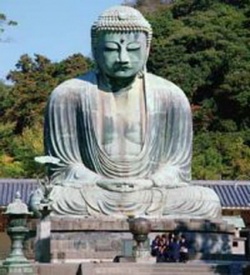Difference between revisions of "Japan"
| Line 1: | Line 1: | ||
[[File:Japan.jpg|thumb|250px|]] | [[File:Japan.jpg|thumb|250px|]] | ||
| − | Japan is a country made up of a number of islands in the northern Pacific Ocean off the Asian mainland. From the 7th century onward the country absorbed Chinese culture, including Buddhism, which became and remained for many centuries the religion of the majority of the people, although Shinto and Confucianism have always been important too. Zen, the contemplative branch of Japanese Buddhism, had a profound influence on the arts especially painting, calligraphy, gardening and flower arranging. Dogen, probably the most brilliant and creative Japanese thinker, was a Buddhist monk. Buddhism was disestablished in 1870 and since then it has struggled to make itself relevant to Japan’s dynamic consumer society. See Jianzhen and Shotoku. | + | [[Japan]] is a country made up of a number of islands in the northern Pacific Ocean off the {{Wiki|Asian}} mainland. From the 7th century onward the country absorbed {{Wiki|Chinese}} {{Wiki|culture}}, including [[Buddhism]], which became and remained for many centuries the [[religion]] of the majority of the [[people]], although [[Shinto]] and {{Wiki|Confucianism}} have always been important too. [[Zen]], the contemplative branch of [[Japanese Buddhism]], had a profound [[influence]] on the arts especially painting, {{Wiki|calligraphy}}, gardening and [[flower]] arranging. [[Dogen]], probably the most brilliant and creative [[Japanese]] thinker, was a [[Buddhist monk]]. [[Buddhism]] was disestablished in 1870 and since then it has struggled to make itself relevant to {{Wiki|Japan’s}} dynamic consumer {{Wiki|society}}. See [[Jianzhen]] and [[Shotoku]]. |
| − | A History of Japanese Buddhism, S. Hanayama, 1966. | + | A {{Wiki|History}} of [[Japanese Buddhism]], S. Hanayama, 1966. |
{{R}} | {{R}} | ||
[http://www.buddhisma2z.com/content.php?id=196 www.buddhisma2z.com] | [http://www.buddhisma2z.com/content.php?id=196 www.buddhisma2z.com] | ||
Latest revision as of 03:41, 20 September 2013
Japan is a country made up of a number of islands in the northern Pacific Ocean off the Asian mainland. From the 7th century onward the country absorbed Chinese culture, including Buddhism, which became and remained for many centuries the religion of the majority of the people, although Shinto and Confucianism have always been important too. Zen, the contemplative branch of Japanese Buddhism, had a profound influence on the arts especially painting, calligraphy, gardening and flower arranging. Dogen, probably the most brilliant and creative Japanese thinker, was a Buddhist monk. Buddhism was disestablished in 1870 and since then it has struggled to make itself relevant to Japan’s dynamic consumer society. See Jianzhen and Shotoku.
A History of Japanese Buddhism, S. Hanayama, 1966.
